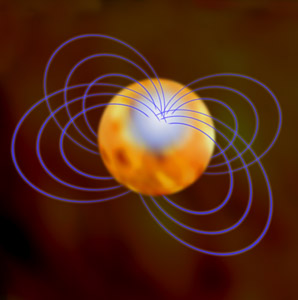Science Behind the Scenes: RX J0720
The press and image releases from the Chandra X-ray Center cover only a small fraction of the science results produced by Chandra each year. Some results are clearly not good candidates for publicity because they're obviously incremental - I've written papers like that myself. Or they can be highly esoteric, addressing questions that only the authors knew enough about the subject to ask! It also doesn't help if the results are completely unsurprising or if there isn't a decent image. But, sometimes we hear about results that we can't immediately give the green light to for publicity, but we can't say no straight away either.
Here's one example of a result that fell into this yellow area, somewhere in between a red and a green light. Press purgatory, if you like. Marten van Kerkwijk, from the University of Toronto and colleagues published a paper last year about surprising behavior by a neutron star, an incredibly dense star left over after a supernova explosion. Unlike the neutron stars that are pulling matter off companion stars, and are responsible for all sorts of weird variable behavior, this particular neutron star appears to be wandering through our galaxy alone. It has the less-than-memorable name of RX J0720.4-3125, but we'll call it RX J0720 for short.
Given its lonely status, big changes in the appearance of RX J0720 weren't expected and people were surprised when changes in its spectrum - the intensity of the X-rays at different wavelengths - were reported back in 2004. van Kerkwijk and his team took a closer look at RX J0720 with Chandra and carefully studied the change in its X-ray spectrum. One interpretation they came up with is that new material had appeared on the surface of the neutron star. They also found the change in the spectrum coincided with a so-called glitch in the spin of RX J0720. Instead of a smooth, slow variation in the spin of RX J0720, a very rapid change occurred, which also could have been caused by new material appearing on the neutron star.

Illustration of a neutron star. Credit: NASA/CXC/M.Weiss
So, where could this material have come from? One interesting idea suggested by the authors is that nearby asteroids have crashed into the surface of the neutron star. Other workers have suggested that neutron stars might have asteroid belts and in this case the amount of mass needed seems to make sense. But, van Kerkwijk explains that this just one of several possible explanations and admits they don't really understand what's going on with this case of "Neutron Star Metamorphosis".
In the end it was this uncertainty about the interpretation and the lack of a good image that caused us to pass on doing a press release for this result. But, it is a good example of some of the cool Chandra science that goes on behind the scenes.
-Peter Edmonds, CXC Press Scientist
Please note this is a moderated blog. No pornography, spam, profanity or discriminatory remarks are allowed. No personal attacks are allowed. Users should stay on topic to keep it relevant for the readers.
Read the privacy statement
